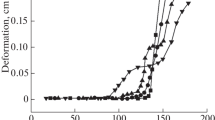Abstract
The molecular polarizability and dipole moments of the fragments of copolymer fluoroelastomers was evaluated by the quantum chemical method. It was shown that the polarity of fluororubbers is provided by the presence of vinylidene fluoride units. The dynamic mechanical analysis method was used to obtain the frequency and temperature dependencies of the storage modulus E′ and the mechanical loss tangent tan δ of fluororubbers and vulcanizates on their basis. The characteristic features of the influence of the rubbers composition and vulcanization on the mechanical and thermophysical characteristics of elastomers were established. The values of tensile strength and elongation at break were obtained for vulcanizates of the studied fluoroelastomers, as well as the Mooney viscosity and the compression set values. The crucial influence of the rubber polarity and the vulcanization network parameters on the specified parameters was identified. The swelling kinetics of rubbers and vulcanizates on their basis in 1,2-dichloroethane at 50°С was studied. The sorption limitation degree of the solvent at the appearance of the vulcanization network and its parameters were evaluated. It was found that with regard to the reduction in their equilibrium degree and swelling rate in dichloroethane, elastomers go in the following order: SKF-26 > Elaftor 3061R > Elaftor 7075 > Elaftor 1000R, symbatically to the decrease in their polarity.





Similar content being viewed by others
REFERENCES
Ameduri, B., Boutevin, B., and Kostov, G., Progr. Polym. Sci., 2001, vol. 26, pp. 105–187. https://doi.org/10.1016/S0079-6700(00)00044-7
Singh, A., Singh, Sh., Soni, P., and Mukherjee, N., J. Macromol. Sci. B, 2019, vol. 59, pp. 1–24. https://doi.org/10.1080/00222348.2019.1679986
Alifanov, E.V., Chaikun, A.M., Naumov, I.S., and Eliseev, O.A., Trudy VIAM, 2017, vol. 50, no. 2, pp. 41–47. https://doi.org/10.18577/2307-6046-2017-0-2-6-6
Beider, E.Ya., Donskoi, A.A., Zhelezina, G.F., Kondrashov, E.K., Sytyi, Yu.V., and Surnin, E.G., Ross. Khim. Zh., 2008, vol. 52, no. 3, pp. 30–44.
Drobny, J.G. and Moore, L.A., Fluoroelastomers Handbook: The Definitive User’s Guide, New York: Elsevier Inc., 2005, 2nd ed.
Da Cunha, F.R., Davidovich, I., Talmon, Y., and Ameduri, B., Polym. Chem., 2020, no. 11, pp. 2430–2440. https://doi.org/10.1039/D0PY00059K
Nudel’man, Z.N., Ftorkauchuki: osnovy, obrabotka, primenenie (Fluoroelastomers: Basics, Processing, Application), Moscow: OOO PIF RIAS, 2007.
Novitskaya, S.P., Nudel’man, Z.N., and Dontsova, A.A., Ftorelastomery (Fluoroelastomers), Moscow: Khimiya, 1988.
Smith, D.W., Handbook of Fluoropolymer Science and Technology, Iyer, S.S., Ed., Wiley, 2014.
Kochetkova, G.V. and Loginov, B.A., Ross. Khim. Zh., 2008, vol. 52, no. 3, pp. 23–25.
Baskin, Z.L., Shabalin, D.A., Vyrazheikin, E.S., and Dedov, S.A., ARoss. Khim. Zh., 2008, vol. 52, no. 3, pp. 13–23.
Fan, C., Li, B., Ren, M., Wu, P., Liu, Y., Chen, T., Cheng, Zh., Qin, J., and Liu, X., RSC Adv., 2015, no. 5, pp.18932–18938. https://doi.org/10.1039/C4RA15096A
GOST (State Standard) R ISO 289-1-2017, Moscow: Standartinform, 2017.
Granovsky, A.A., PC GAMESS Version 7.0. http://classic.chem.msu.su/gran/gamess/index.html
Parr, R.G. and Yang, W., Density-Functional Theory of Atoms and Molecules, New York: Oxford University Press, 1989.
Becke, A.D., J. Chem. Phys., 1993, vol. 98, pp. 5648–5652. https://doi.org/10.1063/1.464913
Zhurko, G.A., Aleksandriiskii, V.V., and Burmistrov, V.A., Zhidk. Krist. i Ikh Praktich. Ispol’z., 2005, nos. 1–2, pp. 13–23.
Aleksandriiskii, V.V., Novikov, I.V., Kuvshinova, S.A., Burmistrov, V.A., and Koifman, O.I., J. Mol. Liq., 2016, vol. 223, pp. 1270–1276. https://doi.org/10.1016/j.molliq.2016.09.064
Andrienko, G.A., Chemcraft, v. 1.8. http://www.chem-craftprog.com
GOST (State Standard) ISO 37-2013, Rezina ili termoplastik: opredelenie uprugoprochnostnykh svoistv pri rastyazhenii (Rubber or Thermoplastic: Determination of Tensile Properties), Moscow: Standartinform, 2014.
Averko-Antonovich, I.Yu. and Bikmullin, R.T., Ucheb. posobie: metody issledovaniya struktury i svoistv polimerov (Textbook: Methods to Study the Structure and Properties of Polymers), Kazan: KGTU, 2002.
Wong, R.S., Ashton, M., and Dodou, K., Pharmaceutics, 2015, no. 7, pp. 305–319. https://doi.org/10.3390/pharmaceutics7030305
Tager, A.A., Fiziko-khimiya polimerov (Physical Chemistry of Polymers), Askadskii, A.A., Ed., Moscow: Nauchnyi Mir, 2007.
Bartenev, G.M., Struktura i relaksatsionnye svoistva elastomerov (Structure and Relaxation Properties of Elastomers), Moscow: Khimiya, 1979.
Funding
The work was carried out within the framework of State Assignment no. FZZW-2020-0008. The dynamic mechanical properties study was carried out using the resources of the Center for Collective Use of Scientific Equipment of the Ivanovo State University of Chemistry and Technology, Federal State Budgetary Educational Institution of Higher Education.
Author information
Authors and Affiliations
Corresponding author
Ethics declarations
No conflict of interest was declared by the authors.
Rights and permissions
About this article
Cite this article
Trifonova, I.P., Simonov, A.S., Rodicheva, Y.A. et al. Influence of the Composition of Fluororubbers on the Properties of Their Vulcanizates. Russ J Gen Chem 91 (Suppl 1), S24–S33 (2021). https://doi.org/10.1134/S107036322113034X
Received:
Revised:
Accepted:
Published:
Issue Date:
DOI: https://doi.org/10.1134/S107036322113034X




